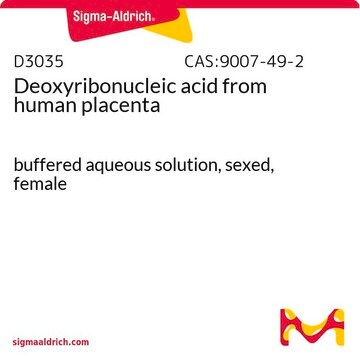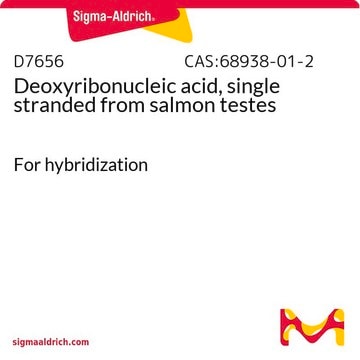11581074001
Roche
COT Human DNA
from human placenta DNA, enriched for repetitive sequences
Sinónimos:
COT Human DNA, Human DNA
Iniciar sesiónpara Ver la Fijación de precios por contrato y de la organización
About This Item
Código UNSPSC:
41106310
Productos recomendados
origen biológico
human placenta (DNA)
Nivel de calidad
grado
Molecular Biology
Formulario
solution
envase
pkg of 500 μg
fabricante / nombre comercial
Roche
concentración
1 mg/mL
impurezas
HCV/HBV, none detected
HIV 1/2, none detected
color
colorless
solubilidad
water: miscible
temp. de almacenamiento
−20°C
¿Está buscando productos similares? Visita Guía de comparación de productos
Categorías relacionadas
Descripción general
Repetitive elements (IRS) present in a probe (e.g., cosmids, YACs, chromosome painting probes) generate nonspecific hybridization signals that are distributed over the whole chromosome or genome. To enable specific hybridization of the probe to the chromosomal target site (e.g., single-copy sequences or low-copy repeats) the probe must be denatured in the presence of excess unlabeled COT Human DNA. This DNA serves as a competitor. In a subsequent preannealing step, the repetitive probe elements rapidly hybridize to excess repeats in the COT Human DNA, while most of the specific probe sequences remain single-stranded and thus can be hybridized to their chromosomal targets. This technique is known as chromosomal in situ suppression (CISS) hybridization.
The COT fraction of human genomic DNA consists largely of rapidly annealing repetitive elements. These interspersed repetitive sequences (IRS) such as SINEs (small interspersed repetitive elements, e.g., Alu-elements) and LINEs (large interspersed repetitive elements, e.g., L1-elements) are distributed ubiquitously throughout the genome. COT Human DNA is prepared from human placental DNA by shearing, denaturing, and reannealing under conditions that enrich these repetitive elements.
Aplicación
COT Human DNA is used in chromosome in situ suppression (CISS) hybridization. Cosmid or YAC probes contain repetitive elements that result in monospecific hybridization signals distributed over the entire chromosome. To enable specific hybridization to the chromosomal target site, the probe is denatured together with an excess of unlabeled COT Human DNA as a competitor. COT Human DNA can be used to suppress nonspecific hybridization to human repetitive sequences in microarray analysis, and in filter and in fluorescent in situ hybridization experiments.
Secuencia
In agarose gel electrophoresis the length distribution of the COT Human DNA fragments shows a maximum in the range of 50 to 300 nucleotides.
Forma física
Solution, 1 mg/ml, 10 mM Tris-HCl, 1 mM EDTA, pH 7.4
Otras notas
For life science research only. Not for use in diagnostic procedures.
Código de clase de almacenamiento
12 - Non Combustible Liquids
Clase de riesgo para el agua (WGK)
nwg
Punto de inflamabilidad (°F)
No data available
Punto de inflamabilidad (°C)
No data available
Elija entre una de las versiones más recientes:
¿Ya tiene este producto?
Encuentre la documentación para los productos que ha comprado recientemente en la Biblioteca de documentos.
Los clientes también vieron
HiCTMap: Detection and Analysis of Chromosome Territory Structure and Position
by High-throughput Imaging
by High-throughput Imaging
Ziad Jowhar
Nature (2017)
Early S-phase cell hypersensitivity to heat stress
Nadezhda V
Cell Cycle (2016)
Nuestro equipo de científicos tiene experiencia en todas las áreas de investigación: Ciencias de la vida, Ciencia de los materiales, Síntesis química, Cromatografía, Analítica y muchas otras.
Póngase en contacto con el Servicio técnico








